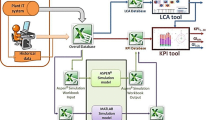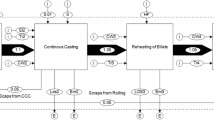Abstract
Goal, scope and background
Integrating environmental issues into the traditional product design process, for powerful eco-efficiency, is now one of the major priorities for steelmakers. Life cycle assessment (LCA) is currently undertaken as the most holistic approach for assessing environmental impact and selecting new technologies to reduce emissions for steel industry. However, in order to identify new ways for environmental friendly production of steel, it is essential to carry out the process Life cycle inventory (LCI) which is the core part of LCA. According to LCA practitioners, the quality and the availability of data are the main important limiting factors when applying this methodology for new steelmaking processes without large industrial application. In this paper, we propose a new approach of LCIA of steelmaking, based on the simulation of traditional processes which guarantees the quality of data, the mass and the energy balances. This approach is validated for an existing integrated plant and will be used to assess the inventory for breakthrough steelmaking technologies.
Methods
The proposed methodological framework combines physicochemical modelling approach with LCA thinking, in order to carry out the LCI of steelmaking process. Using Aspen Plus commercial flow-sheeting software, physicochemical models have been developed for each steelmaking unit: coke plant, sinter plant, blast furnace, basic oxygen furnace and hot-rolling. The association of the five separately developed modules builds the complete flow sheet of the integrated steelmaking plant. Based on chemical reactions, thermodynamics laws and mathematical equations, the model calculates the mass of each pollutant released by the process, the masses and the chemical compositions of products and by-products simultaneously. For a better understanding of this approach, a brief description of the module developed for coke-making plant is given in the current paper.
Results
Thanks to the developed model, the LCI of an existing European integrated steelmaking plant has been calculated and inserted into GaBi software for environmental impacts assessment. In order to check the maturity of the developed approach, simulations of the model have been carried out for virtual cases describing an integrated steelmaking plant, characterised by the best available technology. Comparisons between inventories calculated with the model for “virtual” cases and for existing European plant showed good consistency of results and allowed us to validate the proposed approach.
Discussions
The new approach proposed for LCI calculation offers some important benefits that cannot be obtained when the inventory is carried out in the traditional way. First of all, the model allows us to control the mass and energy balances, something that is basically impossible to assure when only data from industry and/or literature are used. Secondly, calculating emissions based on physicochemical and mathematical considerations gives a strong credibility to the inventory. Predictive model simulations, for special operating conditions (e.g. recycling of different wastes, use of new fuels or mix of fuels), give access to certain environmental information which is not available. The LCI of the integrated steelmaking plant can then be carried out for different operational practices, and the best scenario can be identified in minimal time.
Conclusions
The integrated classical steelmaking route (via blast furnace/converter) has been modelled with Aspen, and the results were successfully compared with industrial data. Consistency of results obtained for simulations of real and virtual integrated plants have shown that the new concept strengthens the LCA method in order to supply rigorous “gate to gate” LCI. It has been shown that the current approach, developed for steelmaking classical route, is mature for modelling new steelmaking breakthrough technologies for environmentally friendly production of steel, such as smelting reduction, direct reduction, hydrogen reduction and use of biomass.
Perspectives
After the selection of steelmaking alternatives and before testing these technological proposals at industrial scale, it is crucial to assess their inventories. As perspective of the current work, the approach proposed in this paper can be used as a powerful tool in order to assess the LCI of new technologies mentioned above.





Similar content being viewed by others
References
IISI World Steel Life Cycle Inventory (2000) Methodology report. International Iron and Steel Institute, Brussels
Iosif A-M (2006) Modélisation physico-chimique de la filière classique de production d’acier pour l’analyse de l’Inventaire de Cycle de Vie. PhD INPL, pp 68–95
Iosif A-M, Hanrot F, Ablitzer D (2008a) Process integrated modelling for steelmaking life cycle inventory analysis. Environ Impact Asses Rev 28:429–438
Iosif A-M, Hanrot F, Ablitzer D (2008b) Application de l’inventaire du cycle de vie en sidérurgie. Technique de l'Ingénieur, M 7 160/vol ME1
Labouze E, Blanc I, Rousseaux P, Gaveglia V (1998) Evaluation de la qualité des données d’inventaires des ACV. n° 96–1002/A-1003/1A. Villeurbanne, Association RECORD, 4
Standard ISO 14040 (1997) Environmental management—life cycle assessment—principles and framework, ISO 14040
Acknowledgements
This work is part of the ULCOS programme and has been supported by the European Commission, in 5th framework programme and by ArcelorMittal Research.
Author information
Authors and Affiliations
Corresponding author
Additional information
Responsible editor: Zuoren Nie
Rights and permissions
About this article
Cite this article
Iosif, AM., Hanrot, F., Birat, JP. et al. Physicochemical modelling of the classical steelmaking route for life cycle inventory analysis. Int J Life Cycle Assess 15, 304–310 (2010). https://doi.org/10.1007/s11367-010-0160-y
Received:
Accepted:
Published:
Issue Date:
DOI: https://doi.org/10.1007/s11367-010-0160-y




